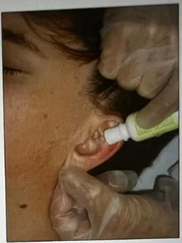The nurse prepares to instill an adolescent client's ear drops as seen in the picture. Which should the nurse do next?

Reposition the dropper.
Pull the auricle up and out.
Visualize the ear drum.
Administer the ear drops.
The Correct Answer is B
A. The dropper should already be positioned correctly, with the tip pointing toward the ear canal.
B. For adolescents and adults, the auricle (outer ear) should be pulled up and out to straighten the ear canal. This allows the ear drops to flow directly into the ear canal, avoiding the tympanic membrane (eardrum). Correctly positioning the auricle helps to prevent irritation and discomfort during ear drop administration.
C. While visualizing the eardrum is important for certain procedures, it's not necessary when administering ear drops.
D. The ear drops should be administered after the auricle is pulled up and out to ensure proper placement in the ear canal.
Nursing Test Bank
Naxlex Comprehensive Predictor Exams
Related Questions
Correct Answer is B
Explanation
A. While documenting the color and clarity of the urine is important for assessing the client's urinary output and potential issues, it is not the immediate next step in the catheter insertion process. This step typically comes after the catheter is fully inserted and secured.
B. Once urine flow is observed, the next step is to inflate the balloon of the indwelling catheter to secure it in place within the bladder. This ensures the catheter remains correctly positioned and does not move out of the bladder, which is crucial for effective drainage and preventing accidental dislodgement.
C. Asking the client to breathe deeply and exhale does not impact the catheterization process and is not related to the next immediate step after observing urine flow. This action might be helpful in other contexts, such as reducing anxiety or discomfort, but it does not address the technical steps required for catheter insertion.
D. If urine flow is observed in the catheter, it indicates that the catheter is already in the bladder. Inserting the catheter an additional inch is unnecessary and could potentially cause trauma or discomfort. Proper catheter placement is confirmed by the observation of urine flow, and additional insertion is not required.
Correct Answer is A
Explanation
A. Asking the client to describe their feelings provides an opportunity to explore their symptoms in more detail, which might help in understanding their pain better. This approach respects the client's experience and opens a dialogue to assess their discomfort more accurately, especially if they are not expressing it verbally or are having difficulty quantifying it.
B. Administering medication without further assessment might be premature. The client's denial of pain and the presence of grimacing and guarding behavior suggest that there may be underlying discomfort, but it's crucial to assess the situation more thoroughly before administering medication.
C. While documenting the client’s verbal denial of pain is important, it should not be the only action taken. The client's non-verbal cues such as grimacing and guarding behavior suggest that they might be experiencing pain despite their verbal denial.
D. Confronting the client could be perceived as accusatory and might make them feel defensive or uncomfortable. It's important to approach the situation with empathy and understanding rather than confrontation.
Whether you are a student looking to ace your exams or a practicing nurse seeking to enhance your expertise , our nursing education contents will empower you with the confidence and competence to make a difference in the lives of patients and become a respected leader in the healthcare field.
Visit Naxlex, invest in your future and unlock endless possibilities with our unparalleled nursing education contents today
Report Wrong Answer on the Current Question
Do you disagree with the answer? If yes, what is your expected answer? Explain.
Kindly be descriptive with the issue you are facing.
